By Cynthia Gibson
Contributing Writer
PALMS — The Los Angeles City Department of Recreation and Parks has converted 60 gymnasiums into virtual learning environments to support students and working parents across the city, while schools are closed during the COVID-19 pandemic.
The Los Angeles City Council voted unanimously Aug. 26 to allocate $10 million to open 50 free alternative learning centers and after-school programs in low-income areas, with $38,000 allocated to upgrade information technology and internet service at city parks. In addition to the low-income learning centers, the department opened 10 fee-based centers in middle-income areas.
“Normally in our gymnasiums, we’d be running sports leagues, adult programs, teen programs, etc., but since the pandemic started, our department has been very involved in addressing many of the issues associated with COVID,” said Vicki Israel, assistant general manager in the Recreation and Parks Department.
The alternative learning centers and after-school programs are patterned after the department’s Summer Play LA, a six-week program where parents could drop off children for a day of organized games and activities set within the COVID-19 guidelines from the Centers for Disease Control and the Los Angeles County Department of Public Health.
Near the end of the program, Israel said parents started asking if the program would be extended. On July 13, Los Angeles Unified School District Superintendent Austin Beutner announced that the district would not reopen schools and remote learning would continue during the new school year.
Based on that decision, as well as Summer Play LA’s success and the need for continued child care for working parents, Israel and Recreation and Parks staff proposed the alternative learning centers and after-school program to help both students and parents make remote learning effective.
The department submitted a report outlining program details to Los Angeles City Council President Nury Martinez and the COVID-19 Recovery and Neighborhood Investment Ad Hoc Committee Aug. 12. The report was partially based on an independent analysis of remote learning in Los Angeles during the first weeks of school closures. The research showed more than 50,000 Black and Latino students were not regularly active on Schoology, LAUSD’s main platform for virtual classrooms, after campuses closed in March.
To address those disparities, the recreation department proposed setting up 50 free program locations based on average income level and park amenities Ten additional locations in middle income areas were suggested. In these areas, parents would pay based on a sliding scale.
Council President Martinez and the COVID-19 Ad-Hoc Committee supported the program and the full Los Angeles City Council approved funding Aug. 26.
Following council approval, recreation department employees had two days to get information out about the program to parents. They especially wanted to reach low-income households and essential workers whose jobs may prevent them from fully supporting the remote learning needs of their children.
The program opened Aug. 31 with 496 children registered at 60 sites.
At most locations, the hours for alternative learning mirror school schedules. Parents can drop off students as early as 8 a.m. Virtual learning is from 9 a.m. to 2:15 p.m. with a lunch break and recess from 11:30 a.m. to 1 p.m. LAUSD provides breakfast and lunch at the free sites. Homework time and organized after-school activities are provided from at 2:15 to 7 p.m.
By Sept. 1, the second day of the program, 13 children were registered at Palms Recreational Center, one of 10 fee-based sites. Palms Recreational Center employee Elisa White was one of two supervisors and several aides monitoring six elementary school students in the program.
White said the most challenging aspects of monitoring an alternative learning center is coordinating a variety of school schedules for each of the students.
The students come from different schools with separate class and break times. Although classes are remote, schools are on different schedules and students are required to travel from one Zoom class to the next in real time. Other students need help navigating the online virtual classrooms themselves.
“In a regular elementary school, daily, they go to music, they go to physical education, they go to art and they go back to their classroom. Now they’re doing all that virtually,” White said. “It’s not like we know to go to classroom 32. We now have to go to Zoom class 32 and find where they’re supposed to be.”
The alternative learning centers and after-school program are scheduled to continue through LAUSD’s winter break, unless in-person learning resumes sooner.
Parks staff transform gyms into learning centers









